Australia's love affair with dividends hits a rocky patch

September 19, 2017, 5:00 AM GMT+10 September 19, 2017, 11:18 AM GMT+10
Telstra’s cut may see other Australian companies follow suit
More companies question ‘blindly paying out dividends’: James
Telstra Corp. is challenging Australia’s addiction to dividends.
The nation’s biggest phone company last month ended a 20-year run of steady dividends, saying it needed to sock away money for new technology. Other firms may follow, undermining Australia’s reputation as a dividend-heavy stock market.

“We’re starting to see more companies say ‘well, rather than just blindly paying out dividends, it’s a case that we need to be mindful of our own internal needs,”’ said Craig James, chief economist at the securities unit of Commonwealth Bank of Australia. “If Telstra does spend money internally, and that is successful in terms of raising its share price and overall returns to investors, then other companies are going to look at the same sort of thing.”
Also read: 5 traps first home buyers should avoid
One of those companies is Santos Ltd. Australia’s third-largest oil and gas producer said in August it won’t pay a half-yearly dividend because it needs to pay off debt. Morgans Financial Ltd. expects the dividend freeze to last for two years.
Telstra’s rivals are also getting in on the act. TPG Telecom Ltd. on Tuesday cut its payment for the year ended in July by 31 percent, saying it needed the money to build wireless networks in Australia and Singapore.
Rising capital expenditure could also hinder shareholder returns. Members of the S&P/ASX 200 benchmark, excluding financial companies, expect to increase spending by 5.8 percent over the next year, the biggest gain since the financial crisis, according to Credit Suisse Group AG.
Australian investors have grown used to regular dividends. The ASX 200 is the top yielding benchmark among the 12 largest stock markets in the world.
Also read: The Byron Bay hotel built by John ‘Strop’ Cornell just sold for $70 million
Franking System
An increasing number of investors are managing their own retirement funds in Australia’s A$2.3 trillion ($2.2 trillion) superannuation industry and expect recurring income. Dividends are particularly attractive because many bring the additional benefit of a tax credit. Under the so-called franking system, introduced in 1987, the tax office doesn’t charge investors a second time when they receive dividends paid out of companies’ post-tax profits.
After listing in 1997, Telstra never scaled back on its dividends as its profit margins fell from the highs of the early 2000s. The former government monopoly, which traces its roots to Australia’s federation in 1901, is facing increasing competition in the mobile market. The roll out of the government-owned National Broadband Network is also hurting. Telstra stands to lose about A$3 billion a year in earnings before taxes, interest, debt and amortization after the NBN’s expected completion around 2020.
At its annual retail investor roadshow this week, the Melbourne-based company will have to convince mom and pop investors it will be in a better position to generate returns after investing in a fifth-generation wireless network and other technologies. Telstra now plans to outlay as little as 70 percent of underlying earnings as the regular dividend instead of distributing the entire profit. That means for the year ending in June, the total dividend will be 22 Australian cents, including any special payments, down from 31 cents in the previous period.
Shareholder Impact
“We fully understand this change will have an impact on our shareholders,” said Chief Financial Officer Warwick Bray. Investors wiped out A$5.5 billion of Telstra’s market value when the move was announced Aug. 17.
Ian Martin, a telecommunications analyst at New Street Research, said Telstra could have maintained the dividend because it continues to generate cash. “It was a very cautious move,” he said.

To be sure, Telstra is still yielding an estimated 6.1 percent, partly because the shares have dropped 29 percent this year. But for now, investors will have to look for additional payments elsewhere and mining stocks may be the temporary answer. BHP Billiton Ltd. and Rio Tinto Group’s dividends are rebounding after last year’s decline amid higher commodity prices.
They’re not a sure fire bet, said Don Hamson, whose Plato Income Maximiser Ltd. invests in dividend-heavy stocks and who is overweight the resource sector. “They are very cyclical and could be down in 12 months time and our views will change again.”
— With assistance by Benjamin Purvis

 Yahoo Finance
Yahoo Finance 
